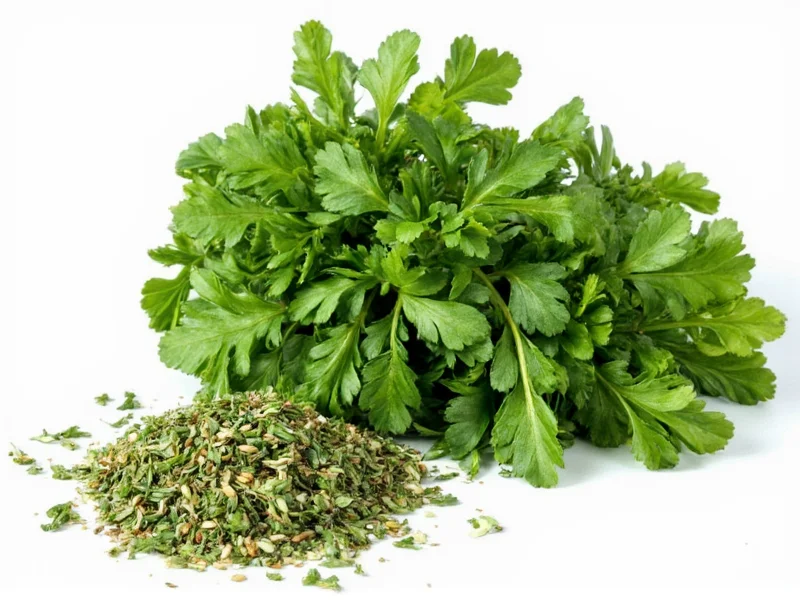Understanding herb conversions is essential for consistent cooking results. When a recipe calls for fresh parsley but you only have dried in your pantry, knowing the proper substitution ratio prevents flavor imbalances in your dishes. The standard culinary conversion guideline states that dried herbs are approximately three times more potent than fresh herbs due to the removal of water content during the drying process.
Why the 3:1 Fresh-to-Dried Conversion Ratio Matters
When herbs are dried, they lose their water content but retain their essential oils and flavor compounds. This concentration means you need significantly less dried herb to achieve similar flavor intensity. For parsley specifically, the volatile oils that give it its distinctive taste become more concentrated when dried.
Using too much dried parsley can result in a bitter, overpowering flavor that dominates your dish. Conversely, using too little will leave your recipe lacking that fresh herbal note. Getting this conversion right affects the final taste profile of sauces, soups, stews, and other dishes where parsley plays a supporting role.
Parsley Conversion Reference Table
| Fresh Parsley | Dried Parsley | Teaspoon Equivalent |
|---|---|---|
| 1 tablespoon | 1 teaspoon | 1 tsp |
| 2 tablespoons (1/8 cup) | 2 teaspoons | 2 tsp |
| 1/4 cup | 1 tablespoon + 1 teaspoon | 4 tsp |
| 1/2 cup | 1/4 cup | 12 tsp |
| 1 cup | 1/3 cup | 16 tsp |
Factors That Affect Parsley Conversion Accuracy
While the 3:1 ratio serves as a reliable starting point for how much dried parsley equals 1/4 cup fresh parsley, several variables can influence the perfect substitution:
- Herb age and storage: Dried herbs lose potency over time. Older dried parsley may require slightly more than the standard conversion
- Drying method: Commercially dried parsley versus home-dehydrated has different concentration levels
- Recipe type: Long-cooking dishes allow dried herbs more time to rehydrate and release flavor, potentially requiring less
- Parsley variety: Curly versus flat-leaf (Italian) parsley have slightly different flavor concentrations
Practical Tips for Using Dried Parsley Successfully
When substituting dried for fresh parsley in your recipes, consider these professional cooking techniques:
- Bloom dried herbs in liquid: Add dried parsley early in the cooking process to liquids that will help rehydrate and distribute the flavor evenly
- Adjust to taste: Start with the standard conversion, then taste and adjust near the end of cooking
- Consider the dish's cooking time: For quick-cooking dishes like omelets or salad dressings, you might need to use slightly less dried parsley than the standard ratio
- Store properly: Keep dried herbs in airtight containers away from light and heat to maintain potency for accurate dried to fresh parsley conversion measurements
When the Standard Ratio Needs Adjustment
Understanding how to convert 1/4 cup fresh parsley to dried isn't always a rigid formula. Certain cooking scenarios warrant adjustments to the standard 3:1 ratio:
For delicate dishes like fish preparations or light sauces, consider using 20-25% less dried parsley than the standard conversion. The concentrated flavor can overwhelm subtle ingredients. Conversely, for robust dishes like hearty stews or tomato-based sauces that cook for hours, you might need to increase the dried parsley by 10-15% since some flavor compounds evaporate during extended cooking.
Always remember that dried parsley lacks the bright, grassy notes of fresh parsley. While it provides earthy depth, it won't deliver the same fresh finish. For garnishes where appearance matters, consider using a small amount of fresh parsley even if the recipe primarily uses dried in the cooking process.
Common Substitution Mistakes to Avoid
Cooks often make these errors when converting between fresh and dried parsley:
- Using equal measurements (1:1 ratio) resulting in overpowering flavor
- Adding dried parsley at the same stage as fresh (dried works better when added earlier)
- Not accounting for the age of dried herbs (older = less potent)
- Confusing measurement systems (using tablespoons instead of teaspoons)
- Forgetting that 1/4 cup fresh parsley conversion to dried requires precise teaspoon measurements
When in doubt about your dried parsley equivalent for 1/4 cup fresh, start with slightly less than the standard conversion, then adjust to taste as your dish cooks. This approach prevents the common mistake of over-seasoning, which cannot be corrected once made.
Storing and Maintaining Parsley Potency
Proper storage significantly impacts how accurately you can apply the 1/4 cup fresh parsley to dried conversion. Dried parsley maintains optimal flavor for 1-2 years when stored correctly in an airtight container away from light, heat, and moisture. After this period, you may need to increase the amount by 25-50% to achieve the same flavor intensity.
For the most accurate how much dried parsley for 1/4 cup fresh measurement, check your dried herbs' potency by rubbing a small amount between your fingers and smelling. If the aroma is faint, you'll need to use more than the standard conversion ratio to compensate for diminished flavor.











 浙公网安备
33010002000092号
浙公网安备
33010002000092号 浙B2-20120091-4
浙B2-20120091-4